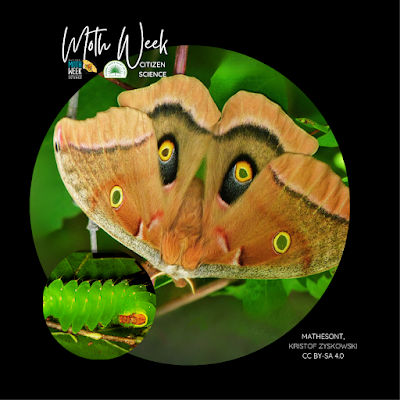National Moth Week 2023 - The Polyphemus Moth
The Polyphemus moth, scientifically known as Antheraea polyphemus, is a North American member of the family Saturniidae, as known as the giant silk moths. It is a tan-colored moth, with an average wingspan of 15 cm (6 in). The most notable feature of the moth is its large, purplish eyespots on its two hindwings. The center of the eyespots are transparent. These famous eyespots give it its name– from the Greek myth of the cyclops Polyphemus.
Though part of the Saturniids much like the Imperial moth, Antheraea’s lineage is different. They come from the subfamily Saturniinae (the Imperial’s is Ceratocampinae, or the royal moths) and specifically the Saturniini tribe. Antheraeas form the tussar silk genus- a wild type of silk that has commercial value especially from its Asian representatives.
This North American moth has a widespread range all over subarctic Canada and the United States. The caterpillar is renowned for its insatiable appetite and can eat 86,000 times its weight at emergence in a little less than two months. Polyphemus moths are considered to be very polyphagous, meaning they rely on a variety of host plants to assist in their gluttony.
In bitter irony, the adults have vestigial mouths meaning their mouth parts, greatly reduced, are incapable of eating anything at all. Because of this, they only live as adults for less than one week. The eyespots form one of the most distinctive defense mechanisms of the Polyphemus moth- a distraction display to confuse predators on its size, identity, and positioning.
The life cycle of the Polyphemus moth is much like that of any other Saturniidae species. It lays flat, light-brown eggs on the leaves of a number of host trees, preferring American elm, birch, and willow, but can also survive on other trees such as oak, maple, hickory, beech, honey locust, walnut, pear and quince, plum, peach, apricot, cherry, sassafras, and even citrus. When the eggs hatch, small yellow caterpillars emerge. Caterpillars feed heavily on their host plant and can grow up to 3–4 inches long.
There are five instars with each instar being slightly different. Polyphemus moth caterpillars can greatly resemble luna moth caterpillars. While polyphemus moths have single horizontal lines along each side of the body, luna moths have vertical yellow lines on each segment. Their fifth and final instar, however, is highly indicative as they become bright green with silver spots on their sides. They then spin cocoons of brown silk, usually wrapped in leaves of the host plant.
Two broods generally hatch each year throughout the United States, one in early spring and one in late summer. The females emit pheromones, which the male can detect through his large plumose (feathery) antennae. Males can fly for miles to reach a female. After they mate, the female spends the majority of the remainder of her life laying eggs while the male may mate several more times.
The North American Polyphemus moth is generally of no economic importance (unlike its Asian tussar silk relatives), although larvae can become occasional pests in plum and hazelnut orchards out west. However, because of their ease of rearing and large size, Polyphemus moths are often reared by amateur enthusiasts and have been used for numerous physiological studies, particularly for studies on molecular mechanisms of sex pheromone action.
"Discover beauty beyond butterflies"- Mark Kateli
Come celebrate moth awareness week collaboratively with National Moth Week and Florida Native Plant Society Like and share your own experiences with us.
Caterpillar image courtesy of Kristoff Zyskowski
Adult image courtesy of Mathesont
Caption provided by FNPS President, Mark Kateli
Instagram: @markkateli | Facebook: Mark Kateli
#mothweek #fnps #antheraeapolyphemus #polyphemusmoth




Comments